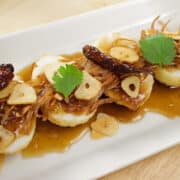Description
A popular Thai dish made from hard boiled eggs, fried to develop a chewy skin, then topped with a sweet and sour tamarind sauce. It's a favourite of kids in Thailand!
Ingredients
- 1 Tbsp finely diced shallots
- 2 Tbsp tamarind paste, store bought or homemade (see note)
- 3 Tbsp (35g) palm sugar, chopped, packed
- 1 Tbsp water
- 1 Tbsp + 1 tsp fish sauce
- 4 medium boiled duck eggs, or 5 chicken eggs, peeled and cooled completely
- 2 head of shallot for fried shallots, thinly sliced lengthwise
- 3-4 cloves garlic for garlic chips (or make as much as you like and keep for miscellaneous sprinkling!)
- Dried chilies, optional
- CIlantro leaves
Do-ahead tips: Boil the eggs and make the sauce in advance and keep refrigerated. The fried garlic, shallots and chilies can also be made in advance as long as you make sure that they are completely crispy, and store them in an airtight container at room temp for up to 2 days.
Instructions
Make the sauce: In a small pot, sauté the chopped shallots with a little oil until the shallots are browned slightly. Add palm sugar, tamarind, water and fish sauce. Let simmer for a few minutes until the sugar is all dissolved and the sauce is thickened slightly. To help the sugar dissolve more quickly, once it has had a minute to simmer in the sauce, the sugar will become soft and you can use a wooden spoon to crush all the lumps (you can see me do this in the video).
After simmering for 3-5 minutes, the sauce should have a darker colour, becomes shiny, and has the consistency of maple syrup (it will thicken slightly as it cools). Taste and adjust seasoning, keeping in mind that the sauce will be mellowed out by the eggs.
Make fried shallots: Thinly slice the shallots and lay them on a plate lined with paper towel. Sprinkle salt over them and let sit for at least 10 minutes. Once it has had time to sit, press a piece of paper towel onto the shallots to absorb all the liquid that has been drawn out by the salt.
Heat just enough oil in a wok or a shallow saucepan to cover the shallots. Turn the heat on medium high and add all the shallots to the oil without waiting for the oil to become hot. Once the shallots are bubbling, turn the heat down to low and keep them bubbling gently until they are golden browned and crispy. Keep an eye on them as they burn quickly! Remove the shallots with a slotted or mesh skimmer and drain on paper towel. Turn off the heat.
Make garlic chips: To the same oil you used the fry shallots, add the garlic slices THEN turn the heat back on low. Keep frying the garlic on low heat (gentle bubbling) until the garlic has turned a light golden colour and the bubbling has stopped. Remove the garlic chips and drain on paper towel. Turn off the heat.
Make fried chilies: To the same oil, add the dried chilies and fry them on low heat until they turn a maroon colour and smell smoky. This will take less than a minute so do not walk away! Remove and drain on paper towel.
Fry the eggs: Add more oil to the pot so that it comes halfway up the eggs. Heat the oil on medium high heat until the oil reaches 375-400°F. While you wait for the oil, dry the eggs really well with paper towel to prevent oil from splattering too much. Then add the eggs to the oil, one at a time and fry them until they become golden brown (it should take just less than 1 minute). Flip the eggs and brown the other side. Remove from heat and drain on paper towel.
To assemble: Cut the eggs in half with a sharp knife and arrange on a plate, cut side up. Reheat the sauce (add a little more water if it has become too thick) then drizzle the sauce over the eggs. Top with fried shallots, garlic, chilies and cilantro. Serve immediately with jasmine rice. Enjoy!
Notes
Tamarind paste is made by combining tamarind pulp with water into a sauce consistency used to add sourness in Thai cooking. You can make tamarind paste from pulp or buy it pre-made (it's often labeled as "tamarind concentrate"). If buying, make sure you're buying a product of Thailand.
